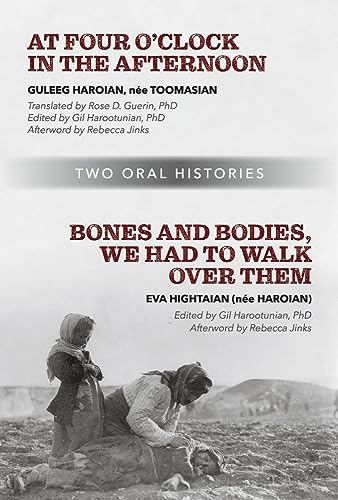
At FOUR O'CLOCK in the AFTERNOON and BONES and BODIES, WE HAD to WALK Over THEM
by Guleeg Haroian
Popularity
3.62 / 5
* A book's popularity is determined by how it compares to all other books on this website.
Where to buy?
Buy from Amazon* If you buy this book through the link above, we may receive a small commission at no extra cost to you.
At FOUR O'CLOCK in the AFTERNOON and BONES and BODIES, WE HAD to WALK Over THEM by Guleeg Haroian
Details
Biography:
No
Published Date:
2023
ISBN13:
9781737555827
Description
Main Themes and Topics
At FOUR O'CLOCK in the AFTERNOON and BONES and BODIES, WE HAD to WALK Over THEM by Guleeg Haroian is a poignant narrative of survival and resilience amidst the atrocities of the 1915 Genocide. The book delves deep into the themes of cultural identity, survival, and the harrowing experience of living through both the 1895 Great Massacres and the 1915 Genocide. It brings to light the forced assimilation and identity erasure that many Armenians faced, drawing parallels with other historical instances of ethnic violence and cultural suppression worldwide.
The narrative particularly emphasizes the impact of forced transfers and marriages, illustrating the severe personal and communal transformations that arose from such traumatic events. It also resonates with broader themes of mother-daughter relationships, as seen through Guleeg Haroian's determination to locate and reclaim her daughter, Eva, from an adopted Muslim household after World War I.
Writing Style and Tone
Guleeg Haroian's narrative is raw and evocative, offering a firsthand account that captures the reader's attention with its authenticity and emotional depth. The style is both descriptive and reflective, allowing readers to inhabit the experiences and emotions of those who lived through these historical atrocities. The language used is imbued with a sense of urgency and purpose, seeking to preserve the memory of the lost and to give voice to those who endured unspeakable hardships.
Additionally, the Afterword by Jinks offers a scholarly lens, juxtaposing the Armenian experience with other instances of ethnic cleansing and cultural assimilation from various parts of the world, thereby enhancing the narrative's depth and relevance for contemporary audiences.
Brief Summary
The book tells the compelling story of Guleeg Haroian and Eva Hightaian (née Haroian), who survived the calamities of the Armenian Genocide via forced transitions into Muslim households. Guleeg's journey of survival includes two marriages to Muslim men amidst the turbulence of war and violence, while Eva's narrative follows her forced adoption into an Arabic household. Guleeg's remarkable resilience is further portrayed as she participates in the vorpahavak, a movement aimed at rescuing Armenian orphans. Overall, the narrative serves as a vital documentary of personal and national history.
Criticism
One of the book's potential criticisms could be that its intense focus on personal narrative may overshadow the broader historical context for some readers. While the firsthand account provides an invaluable human perspective, those seeking a more detailed historical analysis might find the narrative somewhat limited in that regard. However, the inclusion of the Afterword by Jinks partially addresses this by situating the Armenian experience within a wider historical and sociopolitical framework.









